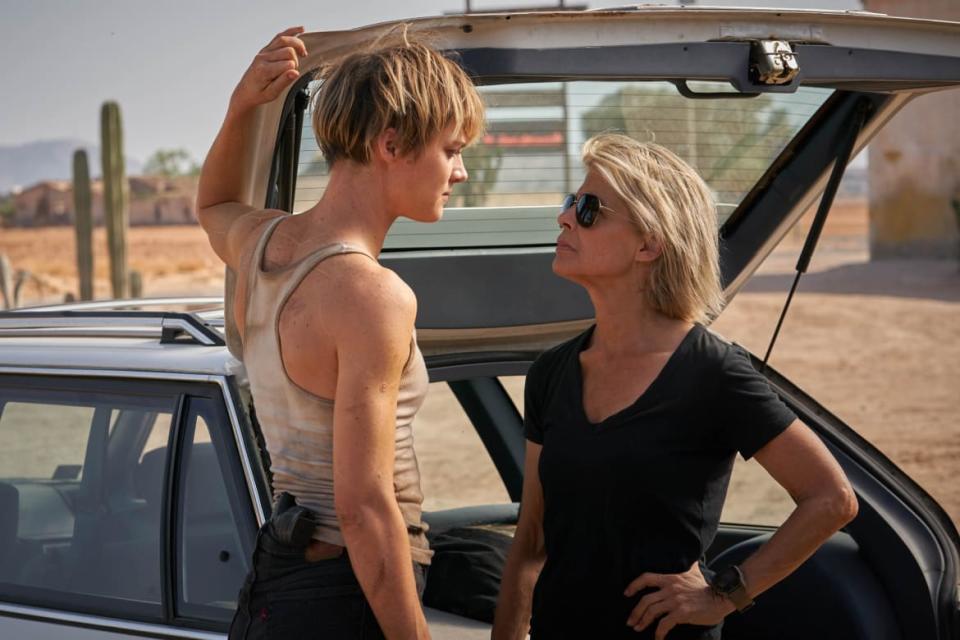Linda Hamilton on the Time She Put James Cameron in His Place: ‘Start Treating Me Like a Human Being!’

It was difficult enough convincing Linda Hamilton to reprise her most famous role.
She’d spent decades distancing herself from Sarah Connor, the iconically tough heroine of Terminator (1984) and Terminator 2: Judgment Day (1991), and the intense celebrity her performance and a short-lived marriage to her director, James Cameron, had imposed on her life. She’d changed her hair and filled her wardrobe with dresses, in contrast with Sarah’s guerrilla combat gear. She’d even left her Malibu mansion behind for a farm in Virginia, where she spent three years before settling into a townhouse in New Orleans in 2015.
It took three voicemails from Cameron before Hamilton finally picked up the phone. Another six weeks passed before she said yes to his idea—to return and play the woman she had turned into one of movies’ most indelible action heroes, this time at 62.
But to submit herself to the motions of the Hollywood machine again—to do press? “God, where do I even begin?” she laughs.
This weekend’s release of Terminator: Dark Fate marks the first time since 1991’s T2 that three of the sci-fi franchise’s original players reassemble: Hamilton, Cameron (who produces and helped shape the story), plus Arnold Schwarzenegger, one-upping his T2 role as an even cuddlier version of the T-800 killer cyborg.
Hamilton’s negotiations with production house Skydance Media kicked off with a single demand: “I said, ‘I’m on board but I’m not doing press.’ That was my opening line,” she says, bursting into a husky, full-throated laugh. She’s sitting here today, on the Los Angeles stop of her “global tour” (a term she drops with a winking, affected accent), in return for the company meeting her asking price. For someone who spent her days chopping firewood just five years ago, these last few months have been strange and long.
“The stylist and the outfits and the, like, 20 looks,” she says helplessly. “I live such a simple life. I don’t have one movie star thing in my closet. Nor do I care to go out and buy them.” The task of “establishing a new identity” on red carpets and talk shows, she decides, has been “very interesting.” She’s more effusive when she frames it all as extra time spent “hanging out with my buddies”: Schwarzenegger, her new costars Mackenzie Davis and Natalia Reyes, and her Dark Fate director Tim Miller. “It’s actually kind of cute.”
James Cameron on the Trump Administration: ‘These People Are Insane’
Hamilton trained for a year—six days a week for three months, then nine months of agility and combat training, plus doctor-prescribed supplements and zero carbohydrates—to transform into a grizzled vision of Sarah Connor “as a woman of a certain age.” She strides into Dark Fate in fit form: with enviable biceps, a grenade launcher, and the casual air of a woman checking her mailbox as she blasts a hole into the deadliest Terminator yet, the Rev-9 (Gabriel Luna).
In some ways, she is still the Sarah of Judgment Day—an exposed nerve of jittery emotion, with little patience for skeptics or her own faults. But 28 years on, there’s a shade of grief behind her ferocity. (Spoilers for Terminator: Dark Fate follow.)
This Sarah saved the world but failed her mission: to protect her son, John Connor. Hamilton calls on guilt to weigh unseen in the slump of her shoulders whenever Sarah mentions him. “I really reached so deep inside of myself to come to this very dark, bitter and lonely place,” Hamilton says. Then, with a grin, “And that was fantastically fun.”
‘Is She Just a Ruin of a Person?’
The opening minutes of Dark Fate reveal that a T-800 gunned John Connor down in Guatemala just months after the events of T2. Sarah, already among America’s most wanted (after blowing up a building and all the wanton destruction in L.A.), has spent nearly 30 years off the grid, alone with her grief for the son she “never had the chance to nurture or love,” Hamilton says.
Sarah criss-crosses the globe to coordinates where Skynet—now obsolete—programmed new T-800s to appear every few years. Destroying them becomes her sole purpose. “I knew before the script arrived that if she’s been killing Terminators, then she would be more machine-like in some ways,” Hamilton says, “because you have to get into the enemy’s mind in order to defeat the enemy. So I just slowly started building the character that way.”

Mackenzie Davis and Linda Hamilton in Terminator: Dark Fate
With Sarah no longer the mother Mary of the future, someone else becomes the target of the next wave of machine uprisings—Dani (Reyes), a young Mexican woman as unseasoned and wide-eyed as the Sarah of 1984. But there is a difference between them that defines Dark Fate’s view of female power. Dani isn’t meant to give birth to a son who will lead the human resistance. She is that leader, as unfathomable as it seems to her. “It’s fantastic growth for women, isn’t it?” Hamilton says with another round of warm, raspy laughter. “You don’t want to just tell the same damn story every time you do the movie.”
The reveal only comes partway through the movie and, for months, Hamilton had no idea it was planned. She was less than pleased: “I said to Tim, ‘I have to say, I’m really kind of disappointed that Dani is just going to be the mother of the future savior of mankind.’ And he let me believe that! He never explained it,” she says. Once she received the script, she was “delighted” with Dani’s surprise role. “And then I called Tim and yelled at him.”
But even with the story shaping up, none among the film’s creative team felt sure of how to imagine a Sarah Connor who has lived with failure for decades. Hamilton wondered whether Sarah might have let herself go, or become an alcoholic. “Is she just a ruin of a person?” she recalls thinking. “None of us really knew. Who would Sarah be now, after her story has changed and John has been killed?” Cameron and Miller bounced ideas back and forth but, in the end, “it was really kind of up to me how to play it,” Hamilton says.
To do that, she drew on years of insight into Sarah’s psyche—the kind only Hamilton could cultivate from her intimate, complicated relationship with the character. Twenty-eight years ago, she watched her image—ripped, ferocious, and impossible to live up to in real life—become a permanent fixture in the public imagination. She retreated from all that. This is how Hamilton found her way back.
‘You’re Terminated, Fucker’
Linda Hamilton was 28 years old when she first zipped into Sarah Connor’s salmon-pink waitress uniform. Back then, a “simpler approach” to the girlish, naive character Cameron had written felt like enough to her. “I didn’t know I was starting this long journey with her,” she says. “I really wasn’t even that thrilled with the movie. You know, it just felt like another job to me.” It wasn’t until she saw the completed film, she concedes, that she “knew James Cameron was a genius.”
Hamilton plays Sarah like an ordinary L.A. girl in the first Terminator. (Exhibit A: after she falls in love with Kyle Reese [Michael Biehn], the man John Connor sends back in time to protect her from a T-800, she daydreams about taking him to Disneyland and the beach.) For much of the film, the massive responsibility Kyle insists she take charge of just stresses her out. “Do I look like the mother of the future? I mean, am I tough, organized? I can’t even balance my checkbook,” she complains.
She’s the less celebrated of Hamilton’s first two versions of Sarah—closer to the unassuming final girl of a horror movie than the bombastic action star she would become—but crucial to our understanding of her electrifying transformation in T2. Hamilton didn’t connect to that early, “so wholesome I could puke” Sarah especially well. But even then, she saw glimmers of potential.
The movie’s climax, in which Sarah discovers her untapped strength, stands out to her. “I do remember loving the moment where I got to stand up when Reese is wounded, and I get him on his feet: ‘On your feet, soldier!’” she says. “That transition from damsel in distress to, all right, she’s got to pull everything she’s got together to get this man up. I remember some of those moments.”
The movie’s love scene between Sarah and Kyle, schmaltzy though it was, also hinted at something that resonated with Hamilton. “There’s a shift where I’m on top of him, and that is sort of a metaphor for what’s about to happen, where I have to get him up and protect him not long after. Things like that struck me,” she explains. “But then I thought we were all done with that! And I left that film.”

Cameron, meanwhile, had seen the steeliness in Hamilton both on and off set. As she explains, it was hard to miss. “Jim and I didn’t not get along, but there was one moment where I’d asked something of him. I wanted to see playback,” she remembers. “A lot of actors are addicted but I never needed to go and look at my performance to make sure I’d gotten it. Never. Until one day.”
With relish, she tells the story of filming Sarah’s first triumph over the T-800—and standing up to Cameron. In the final scenes of Terminator, Sarah crushes the cybernetic monster in a hydraulic press as it grasps for her throat, before she growls out the cathartic line, “You’re terminated, fucker.” The prop mechanics controlling the Terminator’s arm had only a limited view of Hamilton from their spot. “They actually kind of clipped my throat and scared me a little bit, because it’s a 250-pound thing hitting you in the throat,” she remembers. “I felt like maybe I lost my confidence a little bit. And so I asked to see playback for that moment.” The director refused.
“Jim was like, ‘We don’t have time for this, let’s move on,’” Hamilton says, laughing at the nerve. “Well.”
“I went nuts,” she recalls. “I took him off set but, of course, there’s no ceiling so the entire crew could hear. And I shrieeeked at him.” Imagine Sarah Connor's voice in T2 as she lashes out at the psychiatrists who dismiss her visions of the future. That’s the one Hamilton deploys next: “Like, ‘If you want to see a human being on that screen, you better start treating me like a human being!’ I mean, I completely went off. When I finished that film, I was like, well, that director is definitely rooting for the machines.”
‘She Was a Woman in Hell’
Seven years later, Cameron—more than convinced of his leading lady’s toughness—called on Hamilton again to play Sarah in T2. She had one condition: this time, she wanted to go “crazy.”
Cameron indulged her, writing a feral, flawed heroine unlike any seen before (and rarely since) at the center of an action flick. Media at the time often focused on Hamilton’s astonishing physical transformation, which caught the actress by surprise—to her, it was just one of several facets of her reimagined character. “I became this sort of iconic figure of fitness and toughness and I was like, ‘Oh, no, no no, you don’t want to be like her.’ She was a woman in hell, a woman that was suffering horribly. Please don’t mistake who I am for who that character is,” she’d find herself telling reporters more than a decade later.

Hamilton has a few guesses about why Sarah Connor struck such a chord in 1991. Her muscles are part of it; ditto the confluence of cultural forces that primed audiences to welcome a female action hero, to the tune of half a billion dollars at the box office. But also, her hair. Cameron originally proposed that Hamilton chop off her golden-brown locks after Sarah’s escape from an asylum. She argued (successfully) for a ponytail instead—because, as she puts it, “You don’t have to look like a guy to be strong.”
“For some reason I won that argument,” she recalls. “It wasn’t even a vanity thing. And then later on, when she became this icon of strength and you know, the legend of Sarah Connor, I realized that it’s only because I didn’t cut my hair that she became what she did in the minds and hearts of the audience. That was a picture of feminine strength.”
“I would love to say, oh, I was so ahead of my time, but it was really just an instinct that it wasn’t right.” She has an example lined up to prove her point: “I mean, Demi Moore then went and tried to one-up me and did G.I. Jane and courageously cut her hair. And the world didn’t buy it, or like it, you know what I mean?”
At another point in our conversation, Hamilton stops to laugh: “I guess I don’t have a filter.”
‘I’ll Be Back’
It was during the media whirlwind of T2’s release that Hamilton and Cameron moved in together and had a daughter, named Josephine. (She describes their relationship today as “amicable.”) But Hamilton was suffering from undiagnosed bipolar disorder at the time, making an already volatile relationship more difficult.
Exercise helped her escape—it’s partly why, she has speculated, she went so far with her training for Terminator 2. She calls the years between ages 20 and 40, when she finally received a proper diagnosis and treatment, her “lost years.” But these days, she reports with a smile, “I’m great. I’m living the life that I was meant to live.”
Stepping into Sarah’s combat boots again allowed her a “lovely,” familiar window “to just be able to get out of myself. I used to say that being bipolar, it’s kind of like there’s only room for me in my head and it’s still loud and crowded. And that was the way I lived for so long.” After revealing her diagnosis to the Associated Press in 2004, she hit up Oprah and other talk shows as part of a campaign urging people with similar symptoms to find help. “My choice was like, it’s never going to be about me again. I used all that up in my youth,” she says now.
Hamilton saw in Dark Fate a chance to channel “the almost three decades’ worth of life experience that not only have I had, but I’m assuming Sarah Connor has also had.”
“Who is she and what has time done to her?” she wondered, as she parsed what she did and didn’t want for her updated version of the character. “I knew I didn’t want to play her exactly where we left off, because that absolutely is not interesting. Our characters in this franchise are constantly changing. Sarah Connor is evolving, too. I knew that I wanted to have the same element of surprise, and difference, as there was between the first and the second movie.”
A key element again came down to Sarah’s hair. “I dyed my hair white because I didn’t want to be mistaken for Sarah Connor 28 years ago,” Hamilton says. “I was like, I want her to be an old lady. But none of us really knew where we were gong to take the character this time.”
Cameron toyed with the idea of modeling Sarah after the alcoholic Rooster Cogburn in the western True Grit. “But then we’re dealing with weapons and, you know, weapons and alcohol isn’t really the story we want to tell,” Hamilton laughs.
Instead, in Dark Fate, she helps shape Sarah’s story into one about legacy, disappointment, and finding hope in a generation of women leading the future. It’s one only Hamilton could play authentically. “I’ve never mistaken myself for Sarah Connor,” she tells me. “I’m just a woman doing her job and trying to keep up in this world, you know?” Of course, that’s why it works so well.
Got a tip? Send it to The Daily Beast here
Get our top stories in your inbox every day. Sign up now!
Daily Beast Membership: Beast Inside goes deeper on the stories that matter to you. Learn more.

